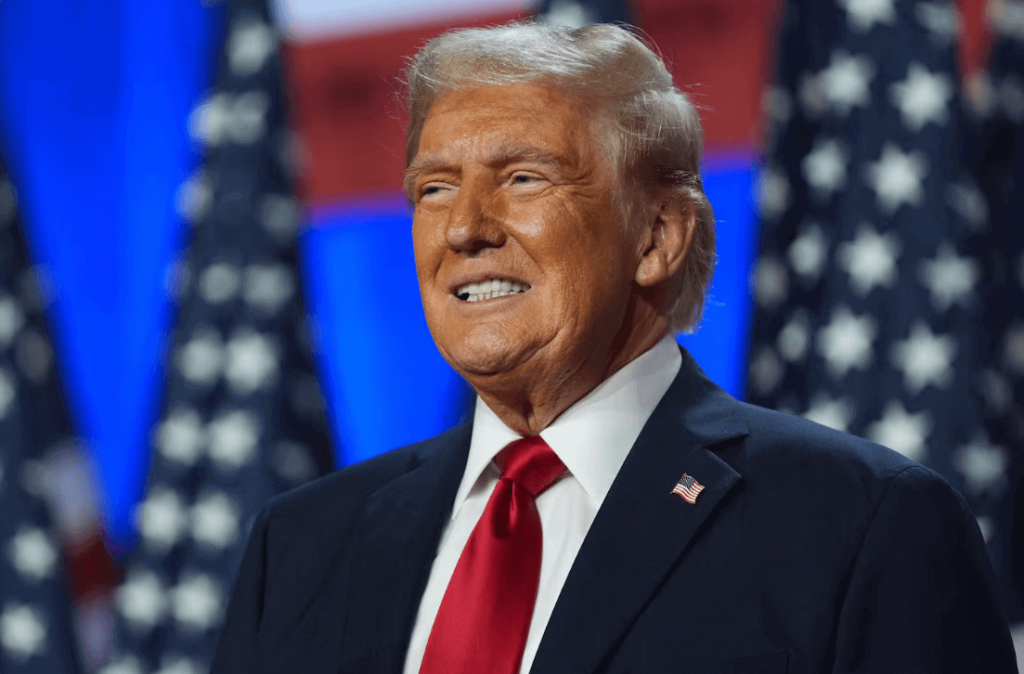【中美创新时报2024 年 11 月 13 日编译讯】(记者温友平编译)当选总统唐纳德·特朗普要求参议院共和党人放弃审查其提名人的角色,这对他的第二任期是否会比第一任期更为激进提出了早期考验。《纽约时报》记者查理·萨维奇对此作了下述报道。
上周末,特朗普在社交媒体上坚称共和党人选择一位愿意宣布休会的新参议院多数党领袖,在此期间他可以单方面任命人员,这一过程将使他能够避开确认程序。他的盟友立即对这个想法表示赞赏,加大了对共和党议员的压力,迫使他们默许。
削弱制衡机制并夺取立法部门部分通常权力的要求凸显了特朗普的独裁冲动。虽然特朗普的请求没有明显的法律障碍,但这将严重违反宪法规范。参议院故意和全面放弃其决定是否确认或拒绝总统授予政府权力的职能,这是史无前例的。
法律评论员埃德·惠兰 (Ed Whelan) 支持特朗普的司法提名人,但批评特朗普本人,他在周二为保守派《国家评论》撰写的一篇文章中敲响了警钟。他写道,这位曾经和未来的总统似乎正在考虑“一个可怕的、违反宪法的想法”。
未经参议院批准就职的休会任命者将行使其办公室的全部权力,直到下一届参议院会议结束。每次国会会议通常持续一年,因此任何在 2025 年初获得特朗普休会任命的人都可以留任到 2026 年底。
宪法通常要求总统获得参议院的同意才能任命行政部门的高级官员,部分原因是为了防止白宫将不合适的人任命为高级公职。
但在建国初期,当旅行是骑马的时候,参议院经常会休会数月,当出现一个关键的空缺,国家需要有人填补时,参议院无法轻易召回。因此,开国元勋们还在宪法中写入了一个例外,允许总统在休会期间临时填补空缺,而无需参议院批准。
休会任命条款在现代时代是一种不合时宜的行为,因为参议院全年开会,必要时可以轻松重新开会。但即使该条款的最初目的已经过时,它仍然是宪法的一部分。
虽然特朗普提名的一些人预计会是国会议员,他们可能会轻易得到共和党控制的参议院的批准,但休会任命将消除对特朗普的一项关键制约,因为特朗普曾考虑将一些强大的角色交给可能难以获得确认的更极端的盟友。
正如亚历山大·汉密尔顿在《联邦党人文集》(为宪法辩护的论文)中所写,这一确认程序的存在本身就是一种保障,可以防止任命“不称职”的官员。
汉密尔顿写道:“一个可以独自决定公职的人,将更多地受其个人倾向和利益的支配,而不是将自己的选择提交给另一个独立机构的讨论和决定,而该机构是立法机构的整个分支。”
最高法院表示,参议院休会至少 10 天足以让总统避开对任命人的确认。为了陷害特朗普,多数党领袖必须愿意提出至少休会一段时间的动议。然后参议院将进行简单多数表决。
如果没有休会动议通过,参议院将继续开会。如果共和党以 53 比 47 的微弱优势占多数,则需要四名共和党人脱离并加入民主党,以阻止特朗普的提议。
有多种理由可以相信,特朗普打破常规的第一任期中有时阻碍其前进的护栏和壁垒在他的第二任期中会变得更弱。
2017 年,他的首任团队经常出现问题,但留下来的人学会了如何更有效地行使权力。他自己的政治任命有时会抑制他的冲动,但这一次,他的盟友决心不任命那些认为有责任制约他的官员。他的议程有时会被法院阻止,但他的任命已将司法系统转向他的方向。
在特朗普的第一任期内,具有独立地位的共和党议员偶尔会表现出谴责他的言论或检查他更具破坏性的提议的意愿。但随着时间的推移,共和党越来越接受特朗普越界的倾向。他压垮了共和党的批评者,让他们坚持了下来,甚至赶走了他们——这表明国会中的共和党人可能更加顺从。
特朗普要求参议院让位,让他进行大规模休会任命,这是大胆的试水第一步。
虽然前几任总统偶尔也会进行一些休会任命,但从来没有人试图系统地绕过参议院的批准,单方面任命政府官员。共和党参议员担心特朗普会通过支持初选挑战者来结束他们的职业生涯,他们是否会放弃他们最重要的权力和特权之一,还有待观察。
在 21 世纪,两大党派之间就总统使用休会任命权的范围和限度存在摩擦。
自 2000 年代中期以来,共和党和民主党都系统地使用所谓的形式会议来阻止总统进行休会任命。当休会时间较长时,每三天就会有一名参议员进入空荡荡的议院,敲响木槌——从技术上讲,将一个长休会分成一系列短休会。
美国总统巴拉克·奥巴马试图挑战这一创新策略,称其违宪,但最高法院在 2014 年维持了这一决定。
特朗普的要求将是一种创新,它朝着另一个方向发展,开创了一个先例,将大幅扩大他的行政权力,削弱立法部门。
虽然他提出的要求是针对行政部门的职位,但休会任命权也适用于司法部门的空缺职位——包括最高法院的空缺职位。但总统们一直犹豫不决是否将这一权力用于司法部门,理由很充分:这种任命被认为是暂时的,不像参议院确认的任命那样保证终身任职。
特朗普在社交媒体上声称,允许他进行休会任命将避免他所说的过去在推动提名人选方面的拖延,他说:“我们需要立即填补职位!”
他没有承认 2019 年由参议院共和党人策划、时任多数党领袖、肯塔基州议员米奇·麦康奈尔 (Mitch McConnell) 领导的重大转变,这一转变严重限制了反对派议员推迟确认投票和占用大量参议院时间的能力。它改变了参议院对大多数行政部门任命的规则,将议员在对提名人进行最终投票前的辩论时间从 30 小时减少到 2 小时。
本文最初发表于《纽约时报》。
题图:共和党总统候选人、前总统唐纳德·特朗普在 2024 年 11 月 6 日星期三在佛罗里达州西棕榈滩棕榈滩会议中心举行的选举之夜观察会上微笑。Evan Vucci/美联社
附原英文报道:
Trump’s recess demand is early test of prospects for more radical second term
By Charlie Savage New York Times,Updated November 13, 2024
FILE – Republican presidential nominee former President Donald Trump smiles at an election night watch party at the Palm Beach Convention Center, Wednesday, Nov. 6, 2024, in West Palm Beach, Fla.Evan Vucci/Associated Press
President-elect Donald Trump’s demand that Senate Republicans surrender their role in vetting his nominees poses an early test of whether his second term will be more radical than his first.
Over the weekend, Trump insisted on social media that Republicans select a new Senate majority leader willing to call recesses during which he could unilaterally appoint personnel, a process that would allow him to sidestep the confirmation process. His allies immediately applauded the idea, intensifying pressure on GOP lawmakers to acquiesce.
The demand to weaken checks and balances and take for himself some of the legislative branch’s usual power underscored Trump’s authoritarian impulses. While there is no obvious legal obstacle to Trump’s request, it would be an extraordinary violation of constitutional norms. There is no historical precedent for a deliberate and wholesale abandonment by the Senate of its function of deciding whether to confirm or reject the president’s choices to bestow with government power.
Ed Whelan, a legal commentator who has supported Trump’s judicial nominees but been critical of Trump himself, sounded the alarm on Tuesday in an essay for the conservative National Review. The once and future president appeared to be contemplating “an awful and anti-constitutional idea,” he wrote.
Recess appointees who take office without Senate confirmation wield the full powers of their offices until the end of the next Senate session. Each congressional session typically lasts a year, so anyone who receives a recess appointment from Trump in early 2025 could remain in office until the end of 2026.
The Constitution normally requires the president to obtain the Senate’s consent to appoint top officials to the executive branch, in part to prevent the White House from installing unfit people to high office.
But in the early days of the country, when travel was by horse, the Senate was regularly out of session for months at a time and could not be readily recalled when a key vacancy arose and the country needed someone to fill it. As a result, the founders also wrote an exception into the Constitution, allowing presidents to temporarily fill vacancies without Senate confirmation when it was in recess.
The recess appointment clause is an anachronism in the modern era, since the Senate meets throughout the year and can easily reconvene when necessary. But even though the clause’s original purpose is obsolete, it remains part of the Constitution.
While some of Trump’s nominees are expected to be members of Congress who will presumably be easily approved by the Republican-controlled Senate, recess appointments would remove a critical check on Trump at a time when he has flirted with also giving some powerful roles to more extreme allies who could face trouble getting confirmed.
As Alexander Hamilton wrote in the Federalist Papers, essays in defense of the Constitution, the mere existence of this confirmation process would act as a safeguard against the appointment of “unfit” officials.
“A man who had himself the sole disposition of offices, would be governed much more by his private inclinations and interests, than when he was bound to submit the propriety of his choice to the discussion and determination of a different and independent body, and that body an entire branch of the legislature,” Hamilton wrote.
The Supreme Court has said that Senate recesses of at least 10 days are sufficient to allow a president to sidestep confirmation for appointees. To set Trump up, the majority leader would have to be willing to bring up a motion to adjourn for at least that amount of time. The Senate would then hold a simple majority vote.
If no adjournment motion passes, the chamber would remain in session. If Republicans hold a narrow 53-47 majority, it would take four Republicans to break away and join Democrats to thwart Trump’s proposal.
There are several reasons to believe that guardrails and bulwarks that sometimes held Trump back in his norm-shattering first term will be weaker in his second term.
His initial team in 2017 was often dysfunctional, but those who stayed learned how to wield power more effectively. His own political appointees sometimes reined in his impulses, but this time, his allies are determined not to appoint officials who would see a duty to constrain him. His agenda was sometimes blocked by courts, but his appointments have shifted the judiciary in his direction.
And in Trump’s first term, Republican lawmakers who had independent standing demonstrated occasional willingness to denounce his rhetoric or check his more disruptive proposals. But over time, the Republican Party has become more accepting of Trump’s propensity to cross lines. And he wore down, outlasted or drove out his GOP critics — suggesting that Republicans in Congress may be even more pliable.
Trump’s demand that the Senate step aside and let him make mass recess appointments is a bold first move to test the waters.
While previous presidents have occasionally made some recess appointments, none has ever tried to systematically bypass Senate approval to unilaterally fill their administrations. It remains to be seen whether Republican senators, fearful of Trump’s ability to end their careers by backing a primary challenger, will give up one of the most important powers and prerogatives of their office.
In the 21st century, there has been friction between the two branches over the scope and limits of what presidents can do with the recess appointment power.
Since the mid-2000s, both Republicans and Democrats have systematically used so-called pro forma sessions to block presidents from making recess appointments. When it adjourns for longer breaks, a senator goes into the otherwise empty chamber every three days and bangs the gavel — technically carving up a long recess into a series of short ones.
President Barack Obama tried to challenge that innovative tactic as unconstitutional, but the Supreme Court upheld it in 2014.
Trump’s demand would be an innovation that cuts in the other direction, setting a precedent that would sharply expand his executive power and weaken the legislative branch.
While he has framed the request in terms of positions in the executive branch, the recess appointment power also applies to judicial vacancies — including on the Supreme Court. But presidents have been hesitant to use that power for the judicial branch for good reason: Such appointments have been understood to be only temporary, with no guarantee of life tenure like Senate-confirmed ones.
On social media, Trump asserted that allowing him to make recess appointments would avoid what he portrayed as past delays in pushing through nominees, saying, “We need positions filled IMMEDIATELY!”
He did not acknowledge a major shift in 2019, engineered by Senate Republicans and led by Mitch McConnell of Kentucky, then the majority leader, that severely curtailed the ability of opposition lawmakers to delay confirmation votes and chew up large amounts of Senate floor time. It changed the chamber’s rules for most executive branch appointments, reducing from 30 to two hours the amount of time lawmakers can debate before a final vote on a nominee.
This article originally appeared in The New York Times.

